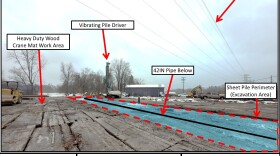Deaths from drug overdose have outpaced automobile accidents as the leading cause of injury in 35 states, including New York. But the state is making strides to curtail that trend. Physicians are integral to treating addiction, but the country has a shortage of doctors with training in the specialty.
“There’s such a need. I remember down in Florida, going into the detoxes, everyone was in there for opioid addiction,” says Seth Skinner, 28, who moved to Rochester almost four years ago. It was another couple years before he got into treatment for opiate addiction. “I think it was hard for the providers, the doctors and the therapists to try to fulfill that need.”
The American Society of Addiction Medicine (ASAM) reports there are over 3,000 board certified addiction medicine physicians. Experts says that’s not enough to help the nearly 25 million Americans over age 12 with addiction.
The University at Buffalo is one of 27 schools in the country with an addiction medicine fellowship program for doctors who want to go into the specialty. Dr. Richard Blondell oversees the UB program and works with the American Board of Addiction Medicine to develop new national programs. He says most doctors receive only hours of education about addiction in med school.
“There are more doctors out there prescribing heavy doses of narcotics than there are out there trying to help people get off of them,” Blondell said. He explains that addiction is a chronic disease, like diabetes, that requires ongoing medical supervision.
Dr. Stuart Gitlow, the immediate past president of ASAM, says few family practitioners think to send their patients with addictions on to another doctor.
“It’s very unlikely, in most parts of the country that they would think to send you to the addiction specialist physician. And there’s a difference. Right? If you go see a counselor, they can do some things, but not everything,” said Gitlow.
One thing a counselor can’t do is prescribe medication. Some patients trying to give up abuse of heroin -- or other opioids -- may be put on methadone, buprenorphine, or naltrexone.
Seth Skinner is a patient that gets buprenorphine, known by the brand name Suboxone. He says he once thought medication was the answer.
“I found out that is not true. Suboxone is a tool. It’s been a great tool for me to stay sober, but it’s been one of the tools that I’ve used to stay sober,” says Skinner.
His doctor, Timothy Wiegand, director of toxicology at the University of Rochester Medical Center, says it takes a team to help his patients stay off heroin.
“The physician is like the quarterback in this setting, working with a lot of really important individuals: the counselors that are running the groups and the individual sessions, the social workers, the care managers,” says Wiegand.
Stigma and misunderstanding of addiction even among medical professionals, says Wiegand, contributes to the lack of treatment. If a diabetic came into the emergency department with a crisis related to their disease, they’d be set up with follow up treatment. That’s not the regular course of action when someone comes in overdosing from heroin.
“They don’t leave with the medications they need to help stabilize the disease of addiction. They don’t leave with a physician appointment, typically, for an addiction medicine specialist, and that’s a huge disparity between these two medical conditions,” Wiegand said.
Some hospitals are now moving to link patients treated in emergency with a long-term treatment programs. But even with growth in the field, treating the 2.4 million Americans addicted to opioids remains a challenge.
Skinner is feeling optimistic about his recovery, but knows how hard it can be.
“It’s a combination of things. It really is. It’s not just one thing. There’s no miracle drug or miracle answer. And everyone’s different.”







